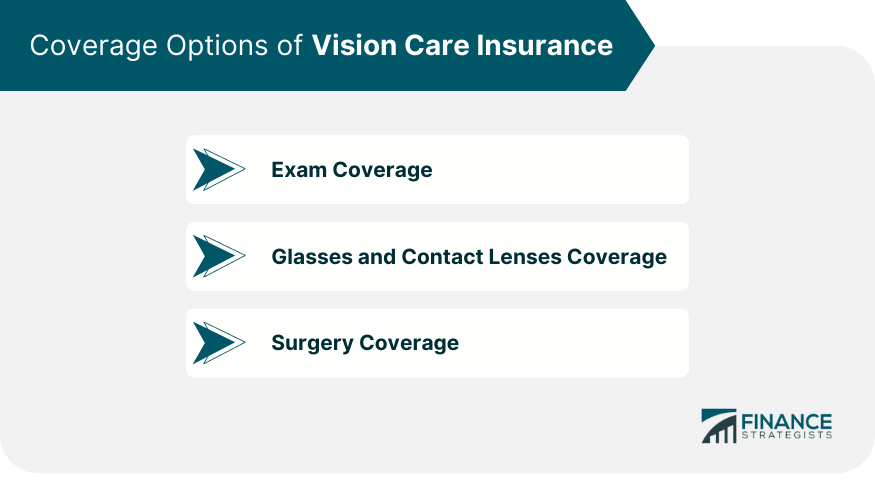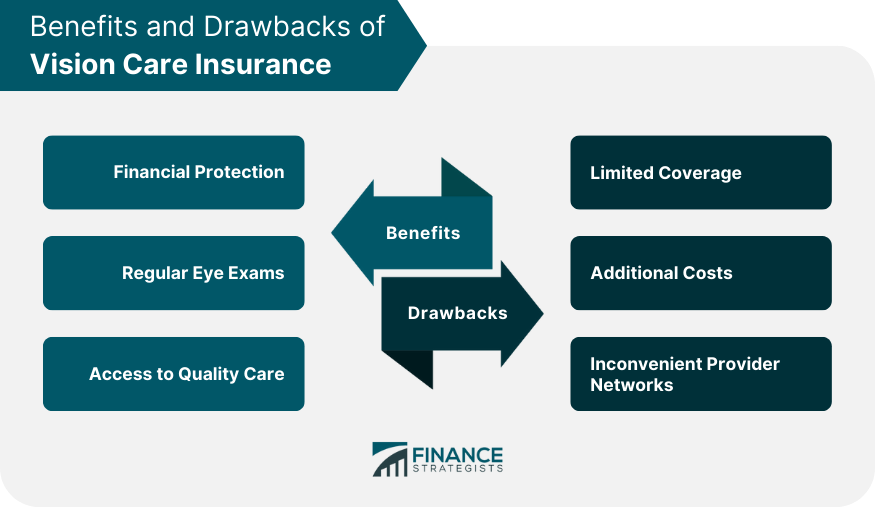Vision care insurance refers to a type of insurance policy designed to help individuals manage the costs associated with maintaining good eye health. It generally covers a range of services, including routine eye exams, prescription eyewear, and certain eye surgeries. In many cases, vision care insurance is offered as an optional benefit within a broader health insurance plan, but it can also be purchased as a standalone policy. The main purpose of vision care insurance is to provide financial assistance for individuals seeking eye care services. By reducing out-of-pocket expenses, policyholders can access necessary treatments and preventative care more easily, ensuring that their vision remains in optimal condition. The importance of vision care insurance cannot be overstated, as it promotes regular eye checkups and helps detect eye problems early on. Regular eye exams are essential for maintaining eye health and identifying potential vision issues that can worsen if left untreated. These exams may help identify eye conditions like glaucoma, cataracts, and macular degeneration, which can lead to permanent vision loss if not properly addressed. Additionally, vision care insurance makes prescription eyewear and contacts more affordable for policyholders, enabling them to correct vision impairments and maintain good eyesight. This is crucial not only for their overall well-being but also for their ability to perform daily tasks and maintain a high quality of life. Vision care insurance typically functions on a benefit schedule, which outlines the specific services covered and the frequency at which they can be accessed. Policyholders usually pay a monthly premium in exchange for coverage, and the insurance provider covers a portion of the cost for eligible eye care services. Depending on the plan, policyholders may be required to pay a copay or meet a deductible before their insurance benefits kick in. Some vision care insurance plans operate within a network of eye care providers, requiring policyholders to choose from a list of approved professionals in order to receive coverage. These networks help keep costs down for both the insurance company and the policyholder, while still ensuring access to quality care. One of the fundamental aspects of vision care insurance is exam coverage. This includes routine eye exams, which typically involve a comprehensive assessment of an individual's eyesight, including visual acuity, eye pressure, and a detailed examination of the eye's internal and external structures. These exams are crucial for detecting potential vision issues and ensuring that proper corrective measures are taken. Many vision care insurance plans cover one annual eye exam, but the frequency and extent of coverage can vary depending on the specific plan. Some policies may offer more frequent exams for individuals with specific eye conditions, while others may only cover basic screenings and require policyholders to pay additional fees for more comprehensive evaluations. Vision care insurance plans often provide coverage for prescription eyewear, including glasses and contact lenses. This coverage typically includes an allowance for frames and lenses, which can be used to offset the cost of purchasing new eyewear. Some plans may also cover the cost of specialty lenses, such as progressive, bifocal, or high-index lenses, but this is not always the case. The extent of coverage for contact lenses can vary significantly between plans. Some policies may cover a specified number of contact lens boxes per year, while others may offer an annual allowance for contacts. In some cases, vision care insurance plans may only cover specific types of contact lenses, such as daily disposable or extended wear lenses. Certain vision care insurance plans also provide coverage for eye surgeries and procedures. This can include treatments for conditions like cataracts, glaucoma, and retinal disorders, as well as corrective procedures such as LASIK and PRK. The level of coverage for these surgeries can vary greatly between plans, with some offering partial coverage and others fully covering the cost of the procedure. It's important to note that not all vision care insurance plans include coverage for eye surgeries, and those that do may have specific limitations or exclusions. Policyholders should carefully review their plan documents to determine the extent of their surgical coverage and any applicable restrictions. One of the primary benefits of vision care insurance is the financial protection it provides. Eye care services, prescription eyewear, and surgeries can be expensive, and without insurance, individuals may struggle to afford these necessary treatments. By covering a portion of these costs, vision care insurance makes eye care more accessible and helps policyholders maintain their eye health without significant financial strain. In addition, vision care insurance can help policyholders budget for eye care expenses more effectively. By paying a monthly premium, they can better anticipate and manage the costs associated with eye care, rather than facing large, unexpected expenses. Vision care insurance encourages policyholders to undergo regular eye exams, which are essential for maintaining good eye health and detecting potential problems early on. By covering the cost of these exams, insurance plans remove financial barriers that might otherwise prevent individuals from seeking regular checkups. Moreover, regular eye exams can help identify underlying health issues that may affect an individual's vision, such as diabetes or high blood pressure. In this way, vision care insurance not only promotes eye health but can also contribute to overall well-being. Vision care insurance plans often work with a network of eye care providers, ensuring that policyholders have access to quality care. These networks typically include optometrists, ophthalmologists, and other eye care specialists who have been vetted and approved by the insurance company. By offering access to these professionals, vision care insurance helps policyholders receive the best possible care for their eyesight. Furthermore, insurance networks can help policyholders find providers who are experienced in treating specific eye conditions, such as glaucoma or retinal disorders. This specialized care can be crucial for effectively managing these conditions and maintaining good eye health. One of the main drawbacks of vision care insurance is that it often provides limited coverage. Many plans only cover a specific set of services and may exclude certain treatments or procedures. For example, some plans may not cover specialty lenses or certain types of contact lenses, leaving policyholders to bear the full cost of these items. Additionally, coverage for eye surgeries can be limited or restricted, depending on the plan. This may leave policyholders with significant out-of-pocket expenses if they require a procedure that is not fully covered by their insurance. While vision care insurance can help offset the cost of eye care services, policyholders may still face additional expenses. Copays, deductibles, and out-of-pocket maximums can add up, particularly for individuals who require frequent eye care or have specific vision needs. Moreover, the monthly premiums for vision care insurance can be an added financial burden, especially for those who are already paying for comprehensive health insurance. It's important for individuals to carefully consider their eye care needs and budget when deciding whether vision care insurance is a worthwhile investment. Some vision care insurance plans have restrictive provider networks, which can limit policyholders' options when seeking eye care services. In these cases, individuals may need to choose from a limited selection of providers or travel long distances to access in-network care. This can be particularly inconvenient for those who have established relationships with eye care providers outside of their insurance network or who require specialized care that is not available within their network. In these situations, policyholders may need to weigh the benefits of in-network coverage against the inconvenience of limited provider options or the potential need to switch providers. When selecting a vision care insurance plan, it's important to carefully compare the options available. This includes considering factors such as the monthly premium, copays, deductibles, and coverage limitations. Policyholders should also evaluate the extent of coverage for eye exams, prescription eyewear, and eye surgeries, as well as any additional benefits or discounts offered by the plan. By thoroughly comparing plans, individuals can better understand the costs and benefits associated with each option, ultimately selecting the policy that best meets their eye care needs and budget. Another critical factor to consider when choosing a vision care insurance plan is the availability of in-network providers. Before enrolling in a plan, individuals should review the provider network to ensure that it includes a sufficient number of eye care professionals in their area. Additionally, policyholders should confirm whether their preferred eye care providers are included in the network, as this can have a significant impact on their overall satisfaction with the plan. If a specific provider is not in-network, individuals may need to decide whether they are willing to switch providers or pay out-of-pocket for their services. Understanding the limitations of a vision care insurance plan is essential to avoid any surprises when accessing eye care services. Policyholders should carefully review the plan documents to identify any coverage exclusions or restrictions that may affect their ability to receive the care they need. This includes examining the frequency of covered services, the types of eyewear and contact lenses that are eligible for coverage, and any limitations on surgical procedures. By being aware of these limitations, policyholders can make informed decisions about their eye care and ensure they receive the appropriate coverage. Vision care insurance plays a vital role in helping individuals manage expenses related to maintaining optimal eye health. By providing coverage for essential services such as eye exams, prescription eyewear, and specific eye surgeries, these insurance plans enable policyholders to access the necessary treatments and preventative care with greater ease. Nonetheless, it is crucial to thoroughly weigh the pros and cons of vision care insurance before committing to a plan. Comparing various plan options, assessing the availability of in-network providers, and being aware of plan limitations are all essential steps in making an informed decision. By doing so, individuals can select the policy that best aligns with their eye care needs and financial considerations. Ultimately, the decision to invest in vision care insurance can have a significant impact on an individual's eye health and overall well-being. By choosing the right plan, policyholders can safeguard their vision and maintain a high quality of life.What Is Vision Care Insurance?
Importance of Vision Care Insurance
How Vision Care Insurance Works
Coverage Options of Vision Care Insurance
Exam Coverage
Glasses and Contact Lenses Coverage
Surgery Coverage

Benefits of Vision Care Insurance
Financial Protection
Regular Eye Exams
Access to Quality Care
Drawbacks of Vision Care Insurance
Limited Coverage
Additional Costs
Inconvenient Provider Networks

Choosing a Vision Care Insurance Plan
Comparison of Plans
In-Network Providers
Plan Limitations
Final Thoughts
Vision Care Insurance FAQs
Vision Care Insurance is a type of insurance policy that provides coverage for vision-related expenses, such as eye exams, glasses, and contact lenses.
Vision Care Insurance covers a range of services, including routine eye exams, prescription glasses and contact lenses, and surgical procedures.
The benefits of Vision Care Insurance include financial protection, regular eye exams, and access to quality care from in-network providers.
The cost of Vision Care Insurance varies depending on the plan you choose, but typically involves monthly premiums, deductibles, and co-payments.
Yes, some of the drawbacks of Vision Care Insurance include limited coverage, additional out-of-pocket costs, and provider network limitations.
True Tamplin is a published author, public speaker, CEO of UpDigital, and founder of Finance Strategists.
True is a Certified Educator in Personal Finance (CEPF®), author of The Handy Financial Ratios Guide, a member of the Society for Advancing Business Editing and Writing, contributes to his financial education site, Finance Strategists, and has spoken to various financial communities such as the CFA Institute, as well as university students like his Alma mater, Biola University, where he received a bachelor of science in business and data analytics.
To learn more about True, visit his personal website or view his author profiles on Amazon, Nasdaq and Forbes.











